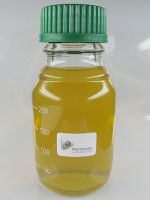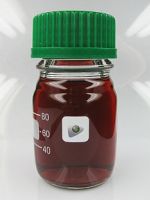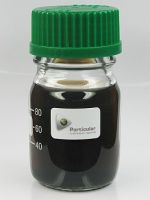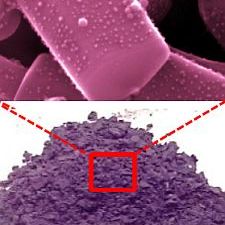This is an image of the Particular GmbH website until the end of 2023. In 2024, the company is in liquidation and can no longer take orders and inquiries.
Nanoparticles by Particular®
Particular produces nanoparticles of highest purity and surface activity,
dispersed in water or solvents or deposited on particulate carrier substrates.

Nanoparticles are our business. Particular produces purest nanoparticles from different materials, dispersed in various solvents. Unlike chemical synthesis, our laser ablation technology ensures that the nanoparticles do not contain chemical residues, and can prevent agglomeration by electrostatic stabilization.
Typical nanoparticle dispersions and supported nanoparticles by Particular can be ordered from our partner STREM Chemicals. Direct links to our colloids are also provided in a "Product Blog". If you require large amounts (in the gram or muliti-liter range) on a regular basis, you may want to contact us directly.
Silver nanoparticles
 Silver nanoparticles are mostly used for their biological properties, but some applications make use of their electrical or optical properties as well. The antimicrobial effect of silver nanoparticles makes them interesting for biological and medical applications: the high chemical reactivity of silver ions allows the silver surface to enter strong bonds with groups containing carbon monoxide, carbon dioxide, or oxygen, which then prevents the spreading of bacteria or fungi.
Silver nanoparticles are mostly used for their biological properties, but some applications make use of their electrical or optical properties as well. The antimicrobial effect of silver nanoparticles makes them interesting for biological and medical applications: the high chemical reactivity of silver ions allows the silver surface to enter strong bonds with groups containing carbon monoxide, carbon dioxide, or oxygen, which then prevents the spreading of bacteria or fungi.
Contrary to most silver nanoparticles on the market, laser-generated nanoparticles are not synthesized chemically, but actually made from real, pure silver by physical laser ablation, preventing chemical impurities. We produce such silver nanoparticles in water and numerous organic solvents, which, together with their purity, provides advantages for new developments in all application areas for nano-silver. Silver-containing alloys, e.g. gold-silver, expand the range of applications with regard to optical properties (plasmon resonance), bioactivity and corrosion-chemical stability (Nano-safety by Design).
Gold nanoparticles
 Gold nanoparticles are mainly used in biotechnology and biomedicine. Their optical absorption spectrum, affinity to thiol groups, and toxicological innocuousness are the main properties that predestine gold nanoparticles for diagnostical and therapeutical applications. In in-vitro analysis, gold nanoparticles are used to locate viruses, bacteria or proteins in rapid tests, making use of their characteristic red color. This effect is well known e.g. from pregnancy tests, cocaine tests or cancer tests. In in-vivo applications, gold nanoparticles can be used in picture-giving localization as well as diagnosis, and hyperthermic treatment allows the targeted destruction of cells.
Gold nanoparticles are mainly used in biotechnology and biomedicine. Their optical absorption spectrum, affinity to thiol groups, and toxicological innocuousness are the main properties that predestine gold nanoparticles for diagnostical and therapeutical applications. In in-vitro analysis, gold nanoparticles are used to locate viruses, bacteria or proteins in rapid tests, making use of their characteristic red color. This effect is well known e.g. from pregnancy tests, cocaine tests or cancer tests. In in-vivo applications, gold nanoparticles can be used in picture-giving localization as well as diagnosis, and hyperthermic treatment allows the targeted destruction of cells.
Contrary to most gold nanoparticles, our nanoparticles are ablated from real, pure gold by physical laser ablation and are therefore free from chemical impurities. Particular produces such colloids and also conjugates ligand-free gold nanoparticles with biomolecules directly during generation. Besides their purity, these gold conjugates excel by superior conjugation efficiencies (for high yield) and surface coverage (for high functionality). The final product is free of citrate or other particle-associated residual chemicals, so that bio-response studies can focus on pure conjugate functionality. In addition, our gold nanoparticles are used in analytics (reduced background in MALDI and SERS) and catalysis (higher process stabilities, see below).
Platinum nanoparticles
 Platinum nanoparticles are especially interesting in catalysis, as platinum is one of the most important materials used in catalytic processes, binding hydrogen, oxygen and other gases. In the form of nanoparticles, platinum has a substantially higher effectiveness because of the increased specific surface area. At sizes of 10 nm, 20 % of the platinum atoms directly interact with the surroundings of the nanoparticle. Platinum also has slight toxic effects on human cells and is therefore used for commercial cancer therapy. Some technical nanoparticle applications also use the conductivity of nano-platinum.
Platinum nanoparticles are especially interesting in catalysis, as platinum is one of the most important materials used in catalytic processes, binding hydrogen, oxygen and other gases. In the form of nanoparticles, platinum has a substantially higher effectiveness because of the increased specific surface area. At sizes of 10 nm, 20 % of the platinum atoms directly interact with the surroundings of the nanoparticle. Platinum also has slight toxic effects on human cells and is therefore used for commercial cancer therapy. Some technical nanoparticle applications also use the conductivity of nano-platinum.
Higher purity of nanoparticles from gold or platinum leads to higher catalytical activity. However, removing ligands from chemically synthesized metal nanoparticles involves effort and costs and is not completely possible. Contrary to most other platinum nanoparticles, ours are not synthesized chemically, but actually made from real, pure platinum by physical laser ablation. These nanoparticles do not contain chemical impurities and are free of ligands. The process also provides them with a large surface activity as the nanoparticles show a large surface defect density. Particular produces such colloids and also directly attaches platinum nanoparticles to catalytic supports during the platinum nanoparticle generation process to ensure highest adsorption efficiencies. Besides their purity, these nanoparticle catalysts excel by highest catalytic activities. Series of platinum alloys can also be made by this process.
Supported nano-catalysts
 Our technology also enables us to deposit and immobilize ligand-free nanocatalysts on carrier substrates in the liquid phase and then extract these "supported nanoparticles" as a dry powder that can be stored for months.
Our technology also enables us to deposit and immobilize ligand-free nanocatalysts on carrier substrates in the liquid phase and then extract these "supported nanoparticles" as a dry powder that can be stored for months.
Our patented method allows nearly free material combinations. A wide spectrum of catalytically active nanomaterials (gold, platinum, palladium, rhodium, custom alloys ...) can be combined with a large variety of supports. STREM Chemicals lists our supported nanomaterials (e.g. "on titania" or "on carbon black") when searching for the respective metal.
Laser-generated particles are stabilized by surface defects that lead to an electrical charge. The absence of ligands improves the affinity to carrier surfaces, while no catalytic centers are blocked by ligands. In a comparison with chemically synthesized nanoparticles (containing rests of citrate), the deposition efficiency has been shown to be a hundred times higher. Titania-supported gold particles from a laser ablation process have proven a higher process stability e.g. in alcohol oxidation. For applications and research, it is generally interesting that the particle load, contrary to that in chemical synthesis, can be adjusted independent of the particle size, as our particles do not grow while processed at room temperature.